The temperatures are decent in the morning and I will be able to start with pleasant kilometers. Once the sun is hitting my bike and panniers, right above my head, the steel is burning and the panniers as well. They act like ovens, so not only I have to quench my thirst with warm salty water, but also I have to witness my stuff “to keep away from direct sun and heat” dying. My vache-qui-rit stock already passed away, the Micropur water purification liquid is forming crystals, and I hope the camera and laptop will survive.

Most of the villages on the road are introduced with the sign of a help program: coopération technique belge, usaid, the hunger project, others less well known … I’ve even noticed Iran as a sponsor for something. Alongside with North Korea who built the controversial Monument de la Renaissance Africaine in Dakar, that’s two countries I rarely see outside of the mainstream news. This is the main road between Touba, Thiès and Dakar, the biggest cities of Senegal, but the traffic is OK. There are not too many trucks, only crowded buses from time to time and 4x4s.
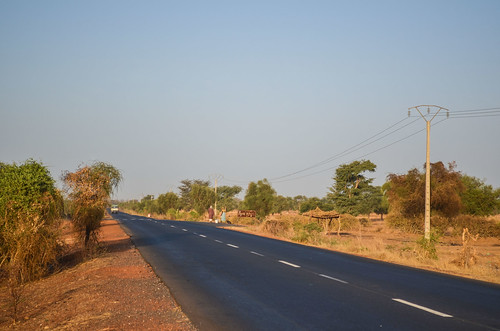
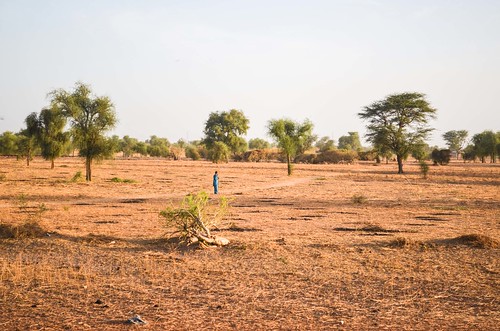
The first city I pass through is Diourbel, where Serigne Touba built his first mosque. I find it more aesthetic than the huge Touba one, which accumulates superlatives over the flooring made of the most expensive marbles.


Along the road runs in parallel the old train line Dakar – Bamako, now operating for passengers only on the short Dakar – Thiès segment.
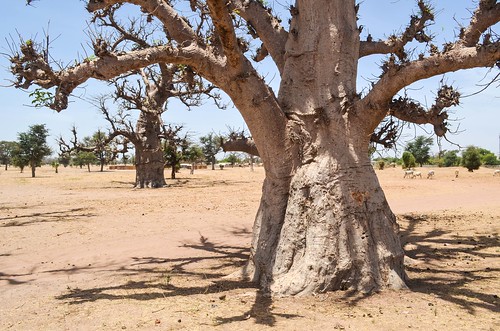
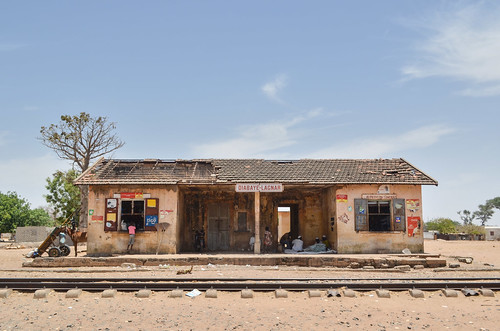
Instead of going to Thiès, I take a turn in Bambey to head north again to the Lompoul desert. There is a piste, which is almost a straight line, until Mekhe, where I should not meet much traffic. Before that, while refreshing in Bambey, I am again a lucky victim of the Senegalese lunch time and am almost forced to finished a thieboudienne and a yassa (kind of curry from peanut paste) dish. We have interesting discussions that make me realize that the best moments I have on the trip are spent in insignificant locations where no one would want to go or stop. Being on a bicycle, it’s actually a good thing to be vulnerable to all possible interactions.
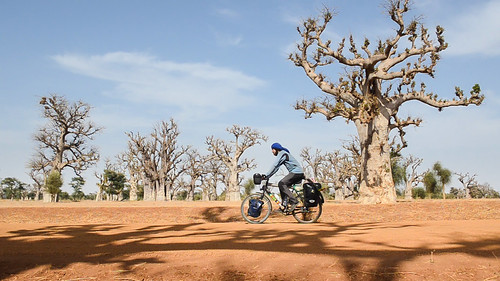
With a stomach overloaded with rice, the long stretch to Mekhe is a repetition of the same landscape over 70 km: dry and hot, goats everywhere, a donkey here and there, baobabs from time to time, and electric cables that do not connect to the villages right under them. At least, there are water taps in the villages, coming from a water tank far enough that I don’t see it. The water is again salty, but I am happy enough to find a tap in a village with no infrastructure kilometers around.
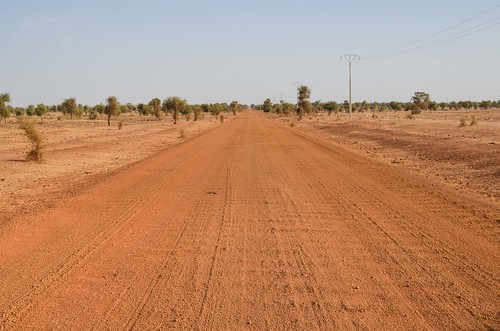
It’s a pleasure to cycle on this red piste in the late afternoon. The temperatures are pleasant (it’s even chill in the evening now, I am closer to the coast), my speed is limited by the corrugated iron road surface, there is no one but a herdsman to salute every 2 or 3 km. The traffic is limited to donkey carts and a car or two per hour. When the sun sets, everything is red in the infinite sight of trees and their shadows.
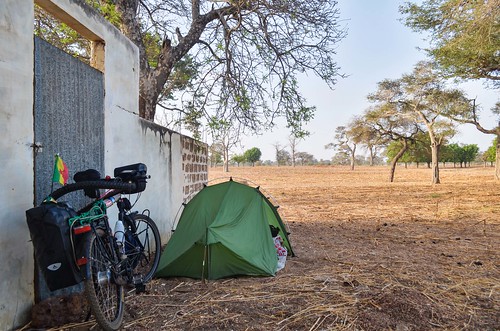
It has been a long time that I didn’t feel the humidity, and this morning the tent is wet. It dries quickly in the sun while the many squirrels run around. I have 30 quiet kilometers to finish on the piste until Mekhe.
My arrival in Mekhe is a complete turn, not on the road, but with the crowd. Having spotted a tap on the street, from which young men are filling their dozen of yellow tanks pulled by the donkey, I put my bike no the wall and wait for my turn to use the tap. At that time, a man comes by to say that the tap water is not free and I must give money to the old lady sitting further away, under a tree. I get quickly surrounded by a small crowd and asked where I’m going, for how long I have been here, “I need a tire, give me yours“, “Eat this, it’s larr” (mil, milk and bananas, delicious), “Go and speak to that lady“, “Take me to South Africa“, “Take this baby goat, it’s 200’000 CFA“, “¿Como te llamas?“, “Why are you in Senegal?“, “Where are you going?” by new people joining the crowd”, “Go and give money to that mama“, “Marry this girl she’s nice“, “What’s this for?” pointing at by bike and touching everything on it, “Sit here“, “Give me a present“, “Let’s exchange our gloves” by a young man arriving with his KTM motorbike and nice gloves, “Give me money“, “Take a bath!” (I’m rather clean, it’s just my shirt that has been carrying the dirt for too many days), “Stay here to rest a bit“, “Stay for lunch“, “Let’s exchange your bicycle with my motorbike” adds the young man with the KTM …
I came out of 70 km on an almost lonely piste and just wanted water. I was not ready for those 20 people surrounding me with so many questions and suggestions within a few minutes and need to keep cool. The novelty effect slowly disappears and I manage to get my water and a baguette, say good bye and be in motion again. Maintaining a speed over 10 km/h is my only escape, although some kids can easily chase me.
I am now on the main axis Saint-Louis – Dakar, going backwards. My loop in northern Senegal has an odd shape. There is a bit more traffic but it remains rather quiet for a main road. In the many villages I cross, I hear a continuous “kadokadokadokadokado ….” (presents) from kids who know nothing in French but “Donne moi …” and “Cadeau“. It lasts from the time they spot me until I am out of their sight. When I hear “Toubab!” it sounds like “Santa!“. The villages have been much nicer in the back country.
I break a third spoke on the flat road, I don’t know why they suddenly abandon me one by one. After almost 100 km, I reach the sea, Lompoul sur mer at night. I went cycling beyond sunset as I knew I had somewhere to go, the VITEL campment of Ibra Fall. It is now cold in the evening. Almost 1 km of bike pushing in the sand until the huts kills my back, even if we are three pushing. But I can finally take a shower and rest in a nice setup.
I spend the next day recovering (it has been a long time I couldn’t sleep until late) and visiting the sight of Lompoul: the Lompoul desert. Lompoul has a tiny desert, which are just dunes over a 4 km long strip. Nothing to compare with the Sahara, but rather playing in the same league with the Tottori sakyuu or the dune du Pyla.
There are a couple of dead fishes on the beach, which is better than a lot of good but dead fishes thrown away by the Chinese fishermen because they’re not interested in them, and infinitely better than the bodies from Saint-Louis when 25 fishermen were taken in a storm on their pirogues, of whom 4 were found in Lompoul.
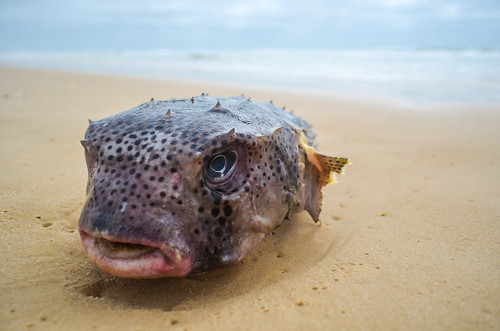
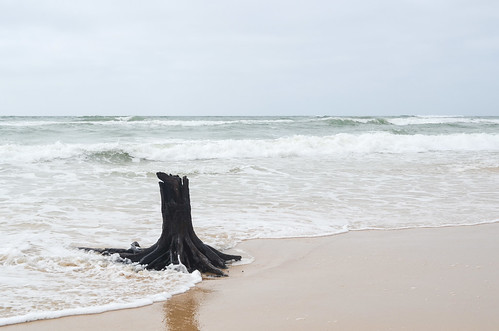
That’s not really a “rest day” to walk 15 km in the sand. The dunes are hidden in the vegetation, without a path (unless going to the tourist campsites) and I wouldn’t have found them from the beach without a villager guiding me.
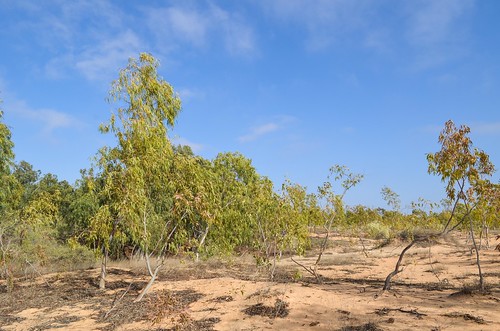

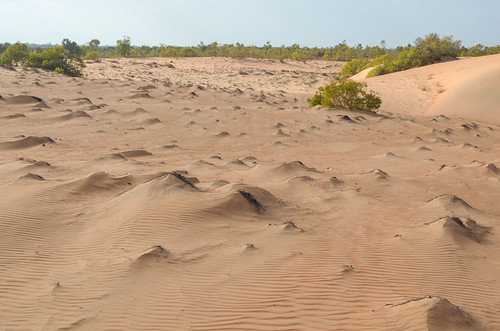
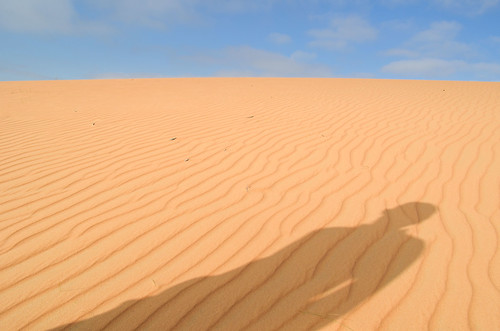
Lompoul is the last stop before Mboro, a town closer to Dakar where I can leave my bike and take holidays from cycling. Mboro is very near, only 45 km away to the south along the beach. The père Fall tells me it’s possible to reach it at low tide, when the sand is as hard as concrete. I’m happy to hear this, because it will save me from cycling 120 km on the main roads, of which I have already cycled 70 km.
I must first change the rear tube, as patching the multiple holes didn’t work out. The Chinese tire changed in Nouadhibou did a good job until the mean thorns from acacia and other trees covering all the Senegalese pistes and roads. Then we wait for the low tide at 5 pm, only to realize that I won’t be able to it. The hard sand is far from being like concrete and the rear wheel is sinking by at least 2 cm, which makes it impossible to cycle. I make a U-turn and use the 2 remaining hours of daylight to make the 40 km back to Kebemer, after which I can camp near a family.

I feel I have slept with goats and chicken in my tent. One goat in its paddock has been bleating at one free chicken running around with the little chicks after it. All around my tent. That’s OK at it’s the last time before holidays …
If kids think I am Santa Claus, many adults think I can distribute residence permits to allow them to work in France. Every time I hear about France, it sounds like a wonderful country where any one can find a job and transfer millions (of CFA) to the family back home. I try to tell them to go to Switzerland instead but it doesn’t work: France is still a paradise where money flows in the pockets of unqualified workers. The illegal boat passenger ticket to the Canaries islands from Senegal is over 500 € and very risky, with high chances to be caught on arrival. Only people who have already worked abroad have a realistic approach on when to go where and which life is best.
There is nothing much to see along the main road and I turn in Tivaouane for Mboro. The only surprise is to see huge mine dumps from a chemical exploitation (phosphates). Those are old, but some new ones will soon appear on the coast as an Australian mining company got the land for the production of zircon and ilmenite. A concession was given for 107 km of coastline on a 4.5 km wide strip, between Mboro and Saint-Louis, for what will become the world’s third biggest zircon mine. I guess those wanting to visit the “grande cote” of Senegal (including Lompoul) and not interested in megatrucks should do it promptly. I have seen, in Mekhe, people working on the abandoned railway Dakar – Saint-Louis. I discussed with a man who thought it could re-open. At that time we didn’t know the work was only aimed at the future transport of the mine’s ore to the port of Dakar.
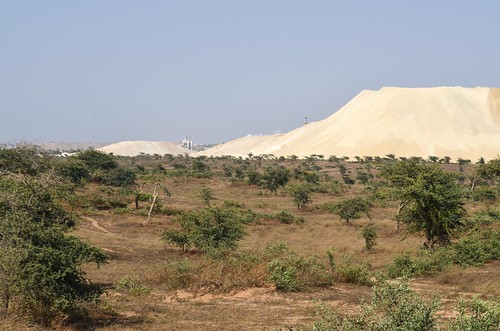
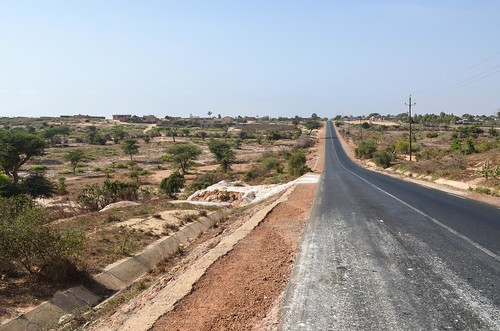
After 10 days with no electricity, strange water, showers in a bucket, pistes and heat, I have a feeling of what will the rest of West Africa look like. For now I remain on the bright side of Senegal, the one with good infrastructure and (relatively) developed tourism to take holidays from cycling.







Leave a Reply